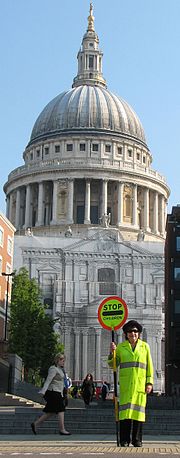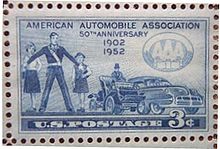- Crossing guard
-
A crossing guard (United States and Canada), a school crossing patrol officer (United Kingdom), school crossing supervisor (Australia) or school road patrol (New Zealand) is a traffic management specialist who is normally stationed on busy roadways to aid pedestrians. Often associated with elementary school children, crossing guards temporarily stop the flow of traffic so pedestrians may cross an intersection. Crossing guards are known by a variety of names, the most widely used in the United Kingdom and Australia being "lollipop lady/man", a reference to the large signs used that resemble lollipops.
Contents
Australia and the United Kingdom
In Australia and the United Kingdom, a school crossing supervisor or school crossing patrol officer is colloquially known as a lollipop man, and lollipop woman/lady, because of the modified circular stop sign he or she carries, which resembles a large lollipop. The term was coined in the 1960s when road safety awareness programs were rolled out in schools throughout the UK. Ventriloquist, John Bouchier, visited schools nationwide with his ventriloquist dummy to help make children more aware of road safety. During these visits John's main character, a young boy named Charlie, referred to crossing patrol officers as "Lollipop men" for the first time. The term became widely used very quickly and has crossed into popular culture, both in the folk world (the common morris-dance tune "The Lollipop Man" has lewd lyrics in one tradition), and in the pop world (see the song by the band Sweet).
In Australia, school crossing supervisors are employed by state government transport authorities and are posted at crossing sites by government officers.
Under UK law it is an offence for a motorist not to stop if signalled to do so by a patroller. In the past patrollers only had the authority to stop the traffic for children. However, the Transport Act 2000 changed the law was so that a patroller had the authority to stop the traffic for any pedestrian[1].
In the UK, the stop sign has the word "STOP", a strip of black, and an international symbol for children (the symbol replaced the written word "CHILDREN"). The black strip is used to record, with chalk, the registration numbers of motorists that do not stop.[2] The patrollers are employed by local authorities, but there is a greater degree of standardisation of the system across the country than in the US. They are often older people who have retired from full-time employment. They may be based at a pelican crossing, a zebra crossing, or just an ordinary point on the road widely used as a crossing.
Due to an increase in abuse, threats and other aggressive behaviour from some drivers, signs with built in hi-tech cameras are being introduced to record offenders, cars and registrations.
New Zealand
In New Zealand, a school crossing patrol, more commonly known as a School Patrol or Road Patrol, was first introduced in 1931 and has been acknowledged in New Zealand legislation since 1944. Students and supervising teachers are in charge of running the patrols each day, with students being trained each year by the New Zealand Police. Around 950 school patrols operate nationally.
The two students on duty control and stop the flow of vehicles approaching a pedestrian crossing (or school crossing point) from either direction allowing school students to safely cross the road. This is done by extending red school patrol signs onto the roadway in one or both directions so that the words "STOP - SCHOOL PATROL" is clearly displayed to any approaching driver. Once the traffic has stopped, one student verbally instructs pedestrians to cross the road.
One of the two students leads the crossing with a series of verbal calls. When a gap in the traffic appears the leader calls "signs out" (both signs are extended onto the road). "Check" (Both students check that traffic is stopping/stopped). "Cross now" (students may cross safely) and finally "signs in" (Signs are withdrawn from road).
All traffic is legally required to stop if one or more signs are being displayed. The stop signs used are mounted onto the pedestrian crossing poles which have a hinged bracket attached, allowing the students to easily and quickly extend (swing) the sign out onto the roadway, during breaks in the traffic. These signs are removed from the poles and stored away while the crossing is not in operation and are usually constructed from aluminum, allowing them to be light and relatively easy to carry by younger students.
Kea Crossings (school patrols that don't operate on pedestrian crossings), and School Traffic Wardens, are also in place at some New Zealand schools where low to medium traffic is present.
United States
Further information: School safety patrolGrowing from concern for the well-being of students walking to school, the Omaha Police Department in Omaha, Nebraska, instituted the first safety patrol in the United States in 1923.[3]
No universal regulations exist that describe who may be a crossing guard, where crossing guards are stationed, or for what purposes a crossing guard may be employed. This person may be paid or volunteer; the person may be a school employee, a member of local law enforcement, a city employee, or contracted privately. Many elementary school crossing guards are assisted by older students, known by a variety of titles such as "safety monitor" and "safety patrol." These do not have legal responsibility for the safety of children and have no legal responsibility.
Crossing guards, except those who are duly sworn public safety officers, have no arrest powers, cannot write tickets, and can only forward the license plate numbers and other descriptors of alleged violators to local law enforcement, who will decide what to do with that information; results may range from nothing at all to a verbal warning to a written summons and fine.
Similar procedures exist in most areas for school bus drivers, who may observe motorists disobeying the bus stop arm or flashing lights usually displayed when children are entering or exiting the bus.
See also
- Pedestrian
- School bus traffic stop laws
- Traffic
- Traffic Guard
- Traffic safety
- Walking bus
References
- ^ Section 270, The Transport Act 2000, HMSO, 2000. Retrieved on 2006-11-20.
- ^ Times Online | Lollicams - the latest weapon in the battle against bad drivers. Retrieved on 2008-05-01
- ^ "History of the Omaha Police Department (1900 - 1990)" City of Omaha Police Department. Retrieved 8/27/07.
Categories:- Pedestrian crossings
Wikimedia Foundation. 2010.


